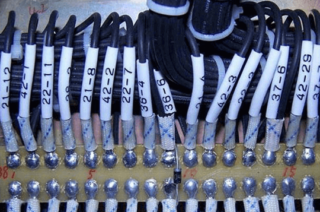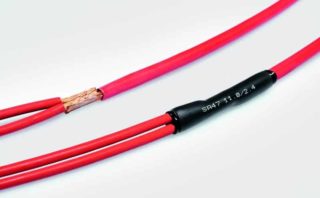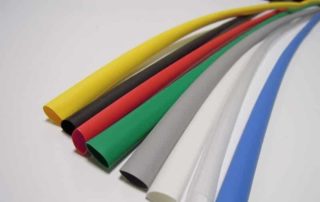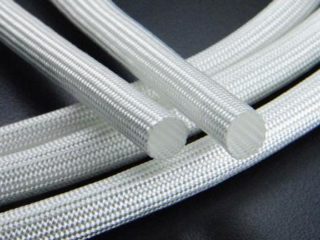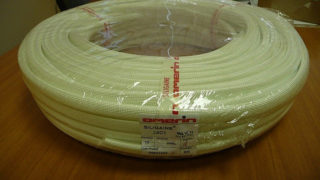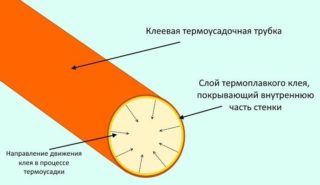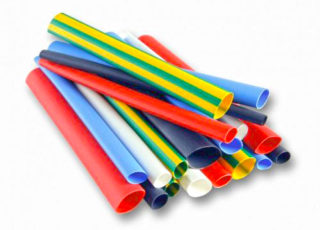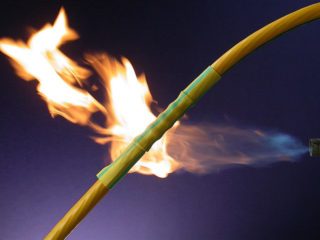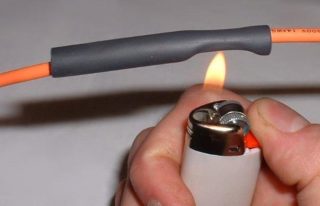If the insulation of the wiring is violated, there are risks to human health and property damage. Cylindrical cambrics for wires are put on the cables and cover them, preventing breaks. The products are a pipe segment and can withstand a voltage of 1000 V.
What are cambrics used for in electrics?
The purpose of the tube is to isolate the electrical network, since the connection must be closed by welding, bolts, soldering, sleeves or terminal lugs. Cambrices are worn on products, then the edges are closed with electrical tape. The free edge is heated and pressed down with pliers.
Termokembrik, in addition to direct use, is used in such cases:
- restoration of the insulating layer of wiring with direct and alternating current;
- marking of contacts - other colors are clearly visible on the white tube;
- cable protection against breaks or damage;
- masking of connection points during wiring;
- additional isolation of substation sections;
- prevention of contacts of the edges of the printed circuit board with each other.
Anglers use cambric to fix floats and hooks or even as bait.
PVC heat shrink tubing or insulator
For the manufacture of products, PVC or a special heat-shrinkable material is used.
Heat Shrink Tubing
They have several advantages:
- operation in a wide range of operating temperatures;
- less harmful emissions during smelting or burning;
- long time of use;
- lack of exposure to aggressive environments.
The special inner coating of the heat-shrinkable tubes remains airtight and sticks well when heated.
PVC cambric
There are 2 types of products:
- From a tube with a circular cross section. Cross-sections on wires are not fixed, have a narrow temperature range and are suitable only for horizontal marking.
- From a rolled tube with an oval cross-section. The profile consumable is mounted on the cable due to the friction of the cable on the inside, it is easily shifted. There should be space near the marked wiring.
Reusable supplies differ in:
- high-quality electrically insulated;
- ability to withstand tensile and mechanical stress;
- the possibility of repeated use;
- lack of expansion in length and width when heated;
- inexpensive cost.
Shrink or PVC cambric in electrics should be used depending on the situation. To protect against short circuits of nearby components, heat shrink is suitable. During heating, open joints are crimped. The diameter of the PVC options is selected solely for the cross-section of the wire.
Types of Cambrian
The properties of insulators depend on the insulating material needed for the manufacture.
Brief classification
By type of application and composition, consumables are:
- Heat-resistant - multi-colored PVC tubes of different diameters to hide stranded wires.
- Thermal dependent - are made on the basis of cotton fabric, fiberglass and resin. Diameters and sizes are the same. Sealed by melting.
Thermocambrics, in turn, are divided into several categories:
- high voltage - due to high resistance, they are used in conditions of high voltage;
- fluorescent - are installed in rooms with poor lighting, because the composition contains particles with illumination;
- corrugated - the textured surface allows you to use the product to prevent slipping;
- Teflon - are not subject to fire, aggressive and chemical environments;
- fiberglass - the main layer is coated with silicone varnish, which ensures the use in the assembly of automatic panels, furnaces with induction hobs;
- cotton - the fabric is impregnated with resin, which ensures its strength, resistance to deformation and good insulating properties.
Fiberglass cambric can be used in the process of connecting heating equipment.
Features of shrink cambric
Shrink consumables are made from polyethylene or other polymers. During heating, the product becomes 2 times smaller, so it is easy to choose for a wire with a different cross-section. The optimal shrinkage coefficient for the diameter is 1: 2, 1: 3 and 1: 4.
As auxiliary means of insulation, various terminals and connections are used, the contours of which will be repeated by heat shrinkage.
The tensile strength of the insulators is 1.5-2 times greater than the initial, but during operation it is important to check the surface for breaks. A lot of colors of heat shrink provides opportunities for marking, breaking wires into groups.
Minus heat shrink tubes - low melting point. At +200 degrees they creep.
Key Benefits
Cambrices are universal consumables for all types of connections, insulation of open cable or wiring. Its operational advantages include:
- demand due to low cost and ease of use;
- universality of use - for mounting on live parts it is enough to choose the right diameter;
- long operating time with proper and uniform heating;
- reusability - the diameter from the old shield is used elsewhere;
- marking conductors and repair damaged or worn markers;
- multifunctionality - various diameters of the tube are suitable for cable coupling, installation of telephone and signal lines with a small voltage.
Light cambric for wire marking is best suited.
Heat resistant fiberglass cambric
The diameters have the main fiberglass layer, and the surface is impregnated with silicone varnish. This manufacturing technology improves electrical performance and provides resistance.
The insulator of the heat-resistant type is practically not used for the arrangement of electrical networks. It is suitable for the assembly of induction cookers, dryers, automatic cabinets and heaters. The purpose of fiberglass cambric is to protect the joints from damage at the time of exposure to high temperature.
Material Specifications
High temperature consumable is different:
- ability to withstand a short maximum temperature of up to +400 degrees;
- prolonged use in the temperature range from -60 to +350 degrees;
- dielectric density from 800 to 1200 V;
- inner diameter of 3-150 mm;
- tolerance +/- 25 mm;
- nominal wall density of 0.4 mm.
The material is completely non-combustible, has excellent strength and thermal conductivity, does not pass current. It is made with a white or black shell.
It is more difficult to work with heat-resistant cambric than with shrink, because external walls have a thickness of 2.5-3 mm.
Areas of use
Heat-resistant tube is chosen for such cases:
- organization of wiring protection with connected cartridge and clamp heating elements;
- cable insulation for household boilers or other equipment (iron, hair dryer, soldering iron);
- protection of connections of electrothermal equipment - drying chambers, tiles;
- concealment of cable and wire connections with heat-resistant properties.
Heat-resistant fiberglass cambric designed for wires does not change the structure when exposed to cold.
Criterias of choice
When buying cambric, you should pay attention to several parameters:
- The diameter of the inside. The optimal size is from 1.5 to 2 core diameters. Manufacturers mark this value before shrinkage (fraction numerator) and after shrinkage (fraction denominator).
- The range of reduction of the polymer layer. The valid parameter is from 1.5 to 2 times.
- Reinforcement. Fiberglass models are hard and cotton allow you to fix the wire in a certain position.
- Resistance to hazardous reactions. Antiprene tubes differ in durability, resistance to ignition.
- Colour. Dense multi-colored or transparent thermotubes are on sale.
- Length. Cambrices are sold in pieces or cable twist.
Dimensions are in inches and centimeters.
How to use Cambrian
In ideal conditions, cambricas sit in several ways.
Building hair dryer
The device gives out a stream of hot air (200-300 degrees), which heats the thermotube. For the exact direction of the jet, you can use a special nozzle. The compound will cool and be solid after 30-40 seconds.
Soldering iron
The heating element is used as an alternative to the hairdryer. For shrinkage of the diameter, a soldering iron casing is required to walk along its surface. You can’t work with a sting:
- traces of carbon deposits will remain on the surface;
- the sting will get dirty;
- cambric will melt at a temperature of more than 300 degrees.
No solder is used to shrink the thermotube.
Sources of fire
Matches or lighters are used as follows:
- The flame burns at a distance of 2-3 cm from the cambric to prevent damage.
- Quick and short movements pass from all sides, controlling the uniformity of contraction.
- The flame of the turbo lighter is directed so that only a stream of hot air enters the tube.
The disadvantage of this method is the trace of burning on Cambric.
The use of heat-shrink and heat-resistant cambric is possible in the organization of electrical communications. The material is popular because of its inexpensive cost and ease of use. High resistance and resistance to combustion provide protection for connection areas and cables.
